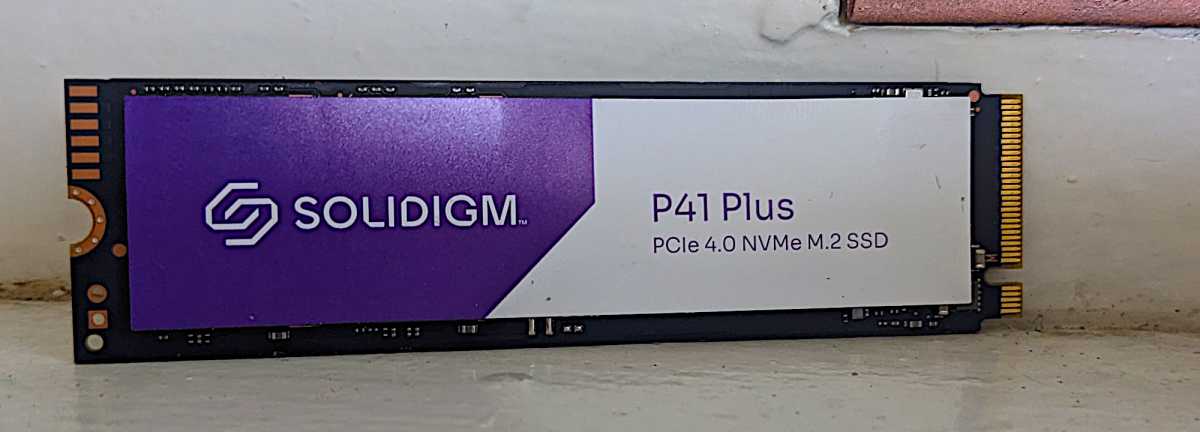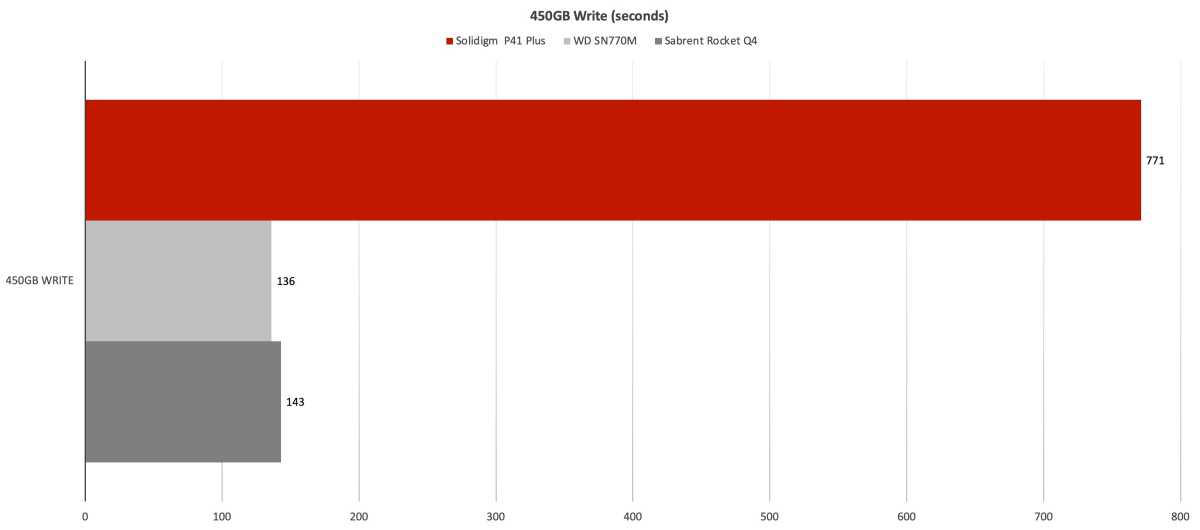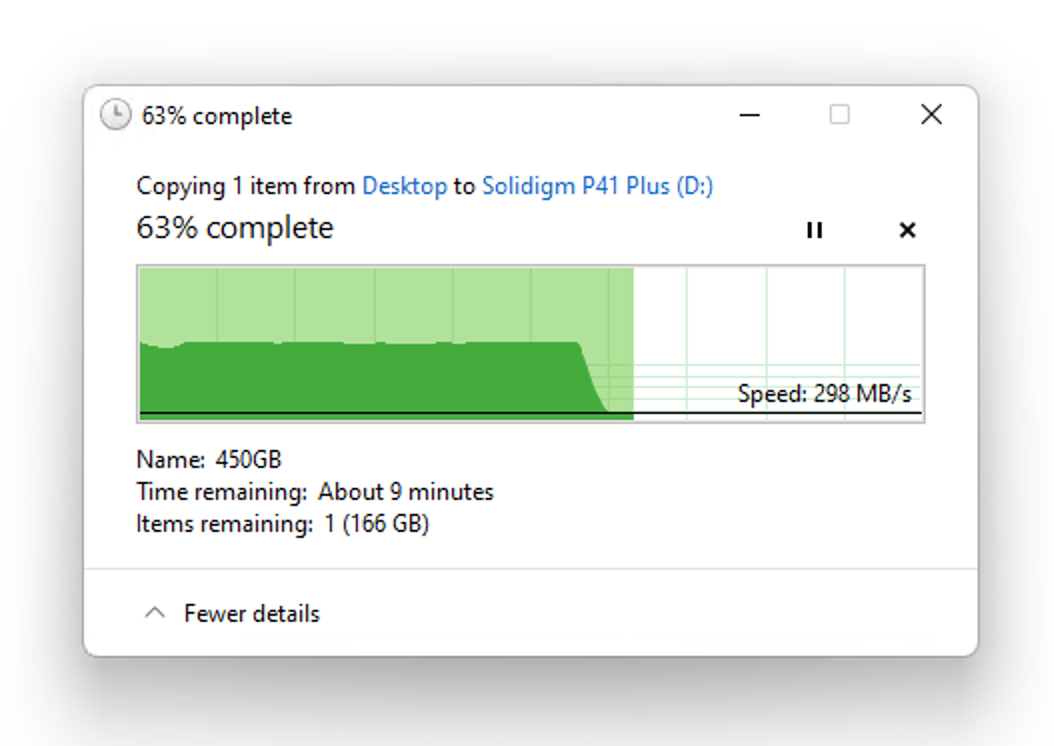Expert's Rating
Pros
- Super affordable
- Good everyday performance
Cons
- Slowed significantly on our long 450GB write
Our Verdict
The Solidigm P41 Plus SSD’s performance is a bit staid for NVMe, but it’s easily fast enough for most users and super affordable
Best Prices Today: Solidigm P41 Plus NVMe SSD
This older design from Solidigm couldn’t quite keep up with newer SSDs in synthetic benchmarks, but it was on par in our real-world transfer tests, given relatively small data sets.
Note that saying an NVMe SSD lagged a tad is a bit like saying the last place F1 car is slow — they all get around the course in a hurry. Moreover, the P41 Plus is available at some startlingly low prices at the time of this writing.
Further reading: See our roundup of the best PCIe 4.0 SSDs to learn about competing products.
What are the P41 Plus features?
The P41 Plus is a host memory bus (HMB) PCIe 4.0 x4 design that uses device memory for primary caching duties. This is enabled by a SMI SM2269XT controller addressing 144-layer QLC NAND. Secondary caching is writing the QLC as one-bit SLC. The drive has been produced in 512GB, 1TB, and 2TB flavors.

Solidigm offers a five-year warranty on the P41 Plus, which is mitigated by a rather paltry 400TBW (terabytes that can be written before the drive wears out) per-terabyte rating. Granted, most QLC SSDs offer relatively low TBW ratings, which is one reason we recommend TLC types whenever possible. Then again, given that most users don’t write all that much data, and the price of this SSD is so low…
How much does the P41 Plus cost?
A the time of this writing, the 512GB P41 Plus was available on Amazon for $37.50, with the 1TB and 2TB models priced at $69.99 and $106.75, respectively. That puts it among the lowest-priced PCIe 4.0 drives we’ve tested.
How fast is the P41 Plus?
The 2TB P41 Plus that we tested didn’t do all that well in the synthetic benchmarks, with one exception, however: It was better than average in our 48GB transfers.

While the P41 Plus’s single-queue 4K numbers (see below) weren’t great, even for an HMB design, it exceeded the norm in the 32-queue read.

The P41 Plus turned in very good 48GB transfer times, losing only to the fastest HMB design we’ve tested, WD’s SN770M — a 2230 (30mm long) form factor SSD.

The P41 Plus fell well off the pace in the 450GB write, largely because it ran out of secondary cache, and the controller didn’t smartly (as some do) allot more. You can see exactly how far in the chart below and the screen capture following.

The P41 Plus fell to around 200MBps to 300MBps when writing its QLC NAND natively, i.e. the full four bits. That’s not great, but hardly the worst we’ve seen recently. The QLC Corsair MP600 Core Mini dropped all the way to 100MBps.
If you aren’t looking for showy benchmark numbers, and don’t transfer large amounts of data regularly, then the P41 Plus will do the job nicely.

I also tested the P41 Plus with Solidigm’s own Windows NVMe driver, which ups the primary HMB caching from 64MB to 78MB. There was a slight uptick in most performance areas, and a nice jump from 16th place overall to 11th in the 48GB transfer test thanks to improved writing of the files and folders mix. Kudos to Solidigm for even writing its own driver.
Should you buy the P41 Plus?
Though it’s not the fastest PCIe 4.0 NVMe SSD on the market by a long shot, all NVMe SSDs are lightning-quick compared to older technologies and don’t bottleneck your system except in extreme cases. If you’re on a budget, aren’t looking for showy benchmark numbers, and don’t transfer large amounts of data regularly, then the P41 Plus will do the job nicely — and save you a fair amount of cash in the process.
How we test
Internal drive tests currently utilize Windows 11, 64-bit running on an X790 (PCIe 4.0/5.0) motherboard/i5-12400 CPU combo with two Kingston Fury 32GB DDR5 4800MHz modules (64GB of memory total). Both 20Gbps USB and Thunderbolt 4 are integrated to the back panel and Intel CPU/GPU graphics are used. The 48GB transfer tests utilize an ImDisk RAM disk taking up 58GB of the 64GB of total memory. The 450GB file is transferred from a 2TB Samsung 990 Pro which also runs the OS.
Each test is performed on a newly formatted and TRIM’d drive so the results are optimal. Note that in normal use, as a drive fills up, performance may decrease due to less NAND for secondary caching, as well as other factors. This is less of a factor with the current crop of SSDs with their far faster NAND.
Caveat: The performance numbers shown apply only to the drive we were shipped and to the capacity tested. SSD performance can and will vary by capacity due to more or fewer chips to shotgun reads/writes across and the amount of NAND available for secondary caching. Vendors also occasionally swap components. If you ever notice a large discrepancy between the performance you experience and that which we report, by all means, let us know.






